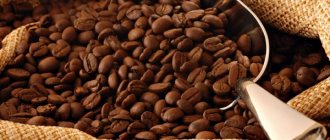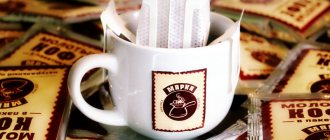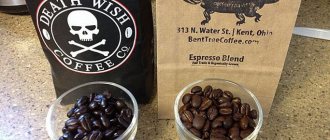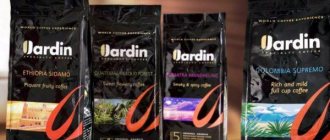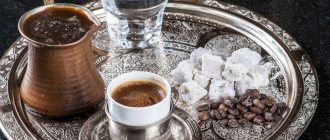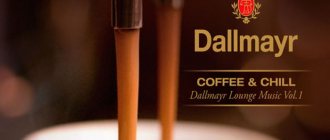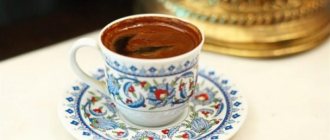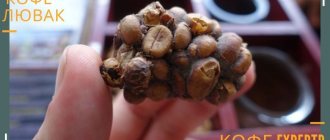Types of coffee
In total there are about 40 species of trees, and yet they vary greatly in external description. There are both shrubs and giants up to 7 meters high. But all types and varieties of coffee have been divided into four main groups, by which the type of drink is determined.
Each group has special properties, differences in grains and taste. It all depends on the place where the tree grows. The main factors of difference are soil and climate.
To obtain beans, mainly 4 types of coffee are used:
Arabica
This is the most popular type of Coffea Arabica or Arabian Coffee tree; its beans have a deep, complex bouquet of taste and aroma.
The plant is quite capricious and requires certain climatic conditions for cultivation - mountain plateaus or the slopes of volcanoes. It prefers climates with sharp temperature changes between day and night. The most serious enemy of Arabica is winter frosts. The annual harvest volume that can be obtained from one plant is 5 kg, from this amount no more than 1 kg of natural coffee beans is obtained.
From one tree per year, about 5 kg of green beans are obtained, after roasting which only 1 kg of finished coffee is obtained. The fruits ripen unevenly, after flowering they take about 9-10 months to grow and ripen. During this period, the tree requires watering, fertilizing and pesticide treatment against pests and diseases. The tree reproduces by seeds, which further complicates and lengthens the growing cycle.
Robusta
Trees of this species were first discovered in Africa in the Congo River basin. Robusta beans contain a lot of caffeine, so they make strong drinks.
Process
This category is quite important for understanding what kind of coffee you will encounter in a given package. Processing is what happens to coffee between the harvesting of the ripe coffee cherries and the packaging of the dry coffee beans. There are four main ways to process coffee harvest:
- Wet processing / Washed Process (Parchment-Dried)
- Natural Drying / Natural Process (Cherry-Dried)
- Honey Process (Mucilage-Dried)
- Wet-Hulled (Seed-Dried)
Each of these methods has a huge impact on the taste of the coffee. In countries such as Colombia, Guatemala and Kenya, coffee is predominantly processed using the wet method. In this process, the skin of the fruit is removed and the coffee is fermented and washed. This treatment produces a pure coffee taste with greater sweetness and aroma.
Natural drying is common in places without access to much water, such as Yemen and Western Ethiopia, or in places where coffee is grown on a large scale, such as Brazil. Using this method, the coffee is dried with the casing on, resulting in the beans acquiring berry aromas.
Honey processing is a mix of the first two options - coffee beans are husked from the fruit, but the remaining layer of sticky coffee juice (so-called coffee honey) is not washed off, and the beans are dried along with it. This type of coffee is common in Costa Rica, El Salvador, and Panama.
The wet peeling method is mainly practiced in Indonesia.
Growing regions
The range of coffee presented on the world market is indeed very wide. This is Arabic coffee, products from Africa, Vietnam, Jamaica. Brazil and Colombia have been considered the undisputed leaders in the market for many decades. In these countries, vast territories are occupied by Arabica and Robusta plantations, and grain exports constitute the main income of the state and its population.
Major global suppliers of coffee products
Coffee is produced in more than 50 countries around the world. Main importers of products:
- Brazil . The main varieties of coffee in the world are produced there. It imports 35% of coffee products, producing it using a dry processing method, and the quality of the drink then suffers.
- Vietnam . Over the past few years, it produces 20% of the world's coffee. Traditional exporters are Russia, Germany, Great Britain.
- Colombia . Produces the world's best Arabica coffee, which is known for its balanced taste.
- Mexico . It produces coffee in large volumes, but only the product that is grown on the mountain slopes is of interest. The rest is usually used in preparing mixtures.
- Nicaragua . Makes a strong drink with a sour taste, obtained after wet processing.
- Ethiopia . Varieties produced in the east of the country are known for their high acidity and winey taste, while those from the south have a bright, rich aroma and fruity taste.
- India . Produces monsoon green coffee with aromas of cardamom, nutmeg and cloves.
- Sumatra . The homeland of many varieties of drink with a bright taste and bitter smell.
In Russia, the prevalence of ground and bean coffee is constantly increasing, and in terms of the level of consumption of instant products, our country ranks first in the world ranking
More than 50 countries around the world grow coffee. But the most important producer of this finished product is Italy. Italian coffee is judged by its main drink - strong, aromatic and invigorating espresso. Many Italian brands have created a variety of special espresso blends so that every lover can prepare a delicious drink at home.
A few words about the Jacobs brand
The history of the Jacobs company begins at the end of the 19th century, when entrepreneur Johann Jacobs from Germany decided to open his own shop with sweets and coffee. Visitors appreciated the grain product most of all, which very soon became very popular. After some time, the entrepreneur expands the scale of his activities and opens a large store on the main street of Bremen.
Thus, at the beginning of the 20th century, the first coffee roasting plant was founded, which was named after Johann Jacobs. A few years later, the Jacobs Kaffee brand was formalized. Since then, the products began to be packaged in branded packaging with the image of a bag filled with coffee beans.
One of the manufacturer’s services was delivery of products to customers’ homes.
During the First World War, the plant was on the verge of closure. Since the sale of coffee beans was prohibited during wartime, Jacobs Kaffee were forced to sell grocery products: sugar, cereals, etc. After the end of the war, coffee products gained popularity again. Then Johann Jacobs, with the support of his talented nephew, revived the enterprise, which began production with redoubled effort. In 1934, the entrepreneur opened a new plant, which at that time employed more than 300 employees.
Since the 60s, Johann Jacobs has handed over the management of the plant to his grandson. The volume of production is growing every year, production is increasing, Jacobs coffee occupies a leading position not only in Germany, but also in other European countries.
Coffee classification
It is very difficult to say with complete confidence how many varieties there are in the world today. The assortment of coffee is wide, because the product is classified according to many criteria; accordingly, the beans differ in taste, richness of aroma and price. The names of coffee varieties are determined by the following criteria:
- Country of Origin;
- by the name of the port from where the product is transported;
- by type of tree;
- by the name of the plantation where the trees are grown;
- by the name of the specific geographical point where the plants are grown;
- in accordance with the international classification;
- commercial name.
By quality
According to the process of preparing raw materials, products are labeled as follows: European preparation (EP) according to the European method (involves the elimination of 8 defects per 300 grams of grain), American preparation (AP) - the American method with the removal of no more than 23 defects per 300 grams.
- elite coffee varieties are marked AA and A;
- good coffee – AB marking;
- grains of medium quality - markings B and BA;
- Low quality grains - marked BB and C.
By geographical location
- grains from mountainous areas - SHG (Striktly High Grown);
- grains grown in the foothills - HG (High Grown);
- grains grown on flat terrain - CS (Central Standard);
- very hard grains - SHB (Strictly Hard Bean);
- hard grains - HB (Hard Bean).
By strength
The strength of coffee depends on how much caffeine it contains. This indicator is also influenced by the following factors:
- Type, variety and region of cultivation . Robusta produces a stronger drink than Arabica. The strongest coffee is made in Africa and the Arabian Peninsula.
- Roasting degree . The strength of the drink reaches its maximum with dark roasting.
- Cooking method . To get an invigorating drink, you need to add more ground grains.
- Cooking method . The longer coffee is brewed, the stronger it becomes.
According to the grain processing process
- AP (American preparation) - preparation according to the American method - no more than 23 defects are removed from every 300 grams of raw materials;
- EP (European preparation) - preparation according to European methods - no more than 8 defects are removed from every 300 grams of raw materials.
According to the age
According to the degree of freshness of coffee beans, the product is divided into two main categories: New crop and Old crop . The first category includes fresh grains that have been packaged immediately after harvesting and processing. The second group includes last year's harvest, from which there are unsold leftovers.
Another classification option involves the presence of age levels such as Mature (Old) and Vintage coffee (Aged coffee). The first point includes grains that have been stored for 1-3 years in special warehouses, and the second includes those that have been stored for 4-10 years.
By grinding degree
There is an opinion that strong natural coffee must have a bitterness. The palette of coffee flavors completely debunks this myth: most blends are created with a high Arabica content, which eliminates the bitter aftertaste even with heavy roasting.
| Grinding | English name | Peculiarity | Extraction time (drink preparation speed) |
| Rude | Coarse grind | Used for preparation in a piston type coffee maker | 6 to 8 minutes |
| Average | Medium grind | Coffee of this grind is considered universal, the raw materials are suitable for preparing any drinks and by any means. | 4 to 6 minutes |
| Thin | Fine grind | Used in filter coffee makers | 1 to 4 minutes |
| Fine espresso | Fine espresso grind | Used in espresso coffee makers | No more than 4 minutes |
| Powdery | Pulverized | This grinding powder is suitable for making Turkish coffee | 7 to 10 minutes |
Different types of coffee may not have the same characteristics. The aromatic drink is selected individually, taking into account your taste preferences. What type of coffee is the most delicious? Even fastidious coffee lovers will not answer this question the same way.
Considering the large number of additives, you can choose an inexpensive type of coffee and enjoy interesting cocktails with the whole family. Others will think that there is no such thing as expensive bad coffee, and will spend a lot of money on their own whim.
By grain size and shape
Grains are sorted by size taking into account the following gradation - from very small grains, the size of which is 4.8 millimeters, to very large grains, measuring more than 8 millimeters. There are a dozen of these sizes in total.
Arabica beans are more oval in shape, Robusta beans are more round. The classification of beans in world coffee production is called screening
(essentially, selection by sifting). The length of Arabica beans ranges from 6 to 15 millimeters; Robusta grain length is from 4 to 9 millimeters.
Caffeine content in beans
The caffeine content in Robusta beans is higher than the content of this substance in Arabica beans - almost twice
. Thanks to this fact, robusta beans are used not only as the basis of coffee drinks, but also for medicinal purposes.
How to cross the sea or ocean? Storage during transport
To transport coffee by water, the exporting company usually rents twenty-foot containers with a capacity of about 20 tons from a shipping company. Storing coffee during transportation is no less important than storing it in warehouses. To reduce the risk of coffee spoilage, containers should have moisture traps and a drainage system. The humidity in the loading container, as in warehouses, should not exceed 70%. It is also necessary to prevent contact of grains with metal surfaces; pallets and pallets are used for this. If all conditions are met, coffee delivery will take place without loss.
An important aspect when delivering coffee to European countries is the difference in temperature overboard and in the hold. When a ship reaches European shores, the air temperature in the ship's storage or containers is much higher than outside, and if there is no ventilation system, the bags of coffee become covered with condensation (sweat), which can lead to the rejection of the entire batch. Therefore, the conditions for transporting coffee are strictly controlled.
Elite varieties
High-quality coffee beans cannot be cheap - true admirers of natural drinks know this. The market has formed a rating of the best manufacturers who care about the high quality of all types of grains and packaging for their storage:
- large Arabica Maragogype from South America (also grown in Nicaragua and Mexico);
- Guatemala Lagos Shb is spicy in taste with an interesting smoky aroma;
- Bourbon Arabica El Salvador Chalatenango with a soft almond hue;
- pure Mocha S >You won’t find expensive (elite) types of beans on the shelves of regular supermarkets. They can only be ordered from catalogs or specialized online stores.
What types of elite coffee are there? The best of them are described below.
Jamaica Blue Mountain is one of the leaders among elite varieties. The beans of this variety have a blue-turquoise hue. The grains are very aromatic, giving the drink a nutty flavor. The drink is too versatile in terms of aftertaste and has good acidity. Due to the fact that the bulk of this rare coffee is purchased by Japan, it is impossible for the average coffee lover to purchase it on the market.
Kopi Luwak is considered one of the most expensive. Produced in Indonesia. A local rodent, nicknamed luwak, is directly involved in its production. It eats ripe coffee beans, and from its feces, partially digested coffee beans are extracted, which are roasted and ground to create a gourmet drink.
Old Java is the so-called aged coffee. It is obtained after 6 years of storing grains under certain conditions. The drink obtained from them has a thick consistency and unusual aroma.
Coffee varieties are a very broad concept. It is difficult to describe their exact number, but we were able to describe the majority of those on the market in this article.
Exotic coffees
For a long time, Kopi Luwak was considered the most expensive and exotic type of coffee. The luwak grains processed in the stomach of the animal got rid of natural bitterness and acquired an interesting chocolate flavor. The aromatic variety of coffee is obtained without the involvement of breeders and the latest technologies - the animal eats only the ripe, best fruits. Price – from 400 to 1000 $/kg.
There is a cheaper version of a rare variety of coffee - Monkey Coffee, obtained by Taiwanese farmers. The technology is similar to the first type, but Formosan monkeys are used to process the grains. This significantly reduced the price to $45-50/kg. The finished drink has a pronounced vanilla flavor.
Equipment for preparing coffee drinks
Classic coffee is prepared in a cezve. Coffee beans were brewed in it long before coffee machines were invented. This vessel with a narrowed neck is still used today. An alternative option is a French press. It manages to prepare a fairly strong, aromatic drink. It works on the principle of a press. After infusion, coffee powder is squeezed out in it.
Additional accessories include:
- coffee grinder - can be electric or manual;
- pitcher - designed for frothing milk;
- espresso shot - is a measuring cup that is used when preparing espresso;
- tamper - presses coffee powder when brewing a drink in a coffee machine;
- shaker - used when necessary to mix ingredients.
Unusual devices may also be used. Among them:
- Chemex. It consists of a flask and a funnel connected by a leather rim.
- Purover . The design consists of a funnel with a spiral bottom and a base that is placed on a cup.
- Aeropress . A relatively new invention that is placed on a mug with the filter facing down. Coffee powder is placed in it and water is poured in. The thicket is pressed down with a press.
Aeropress
Chemex
Pour over
Understanding all types of coffee is not as difficult as it might initially seem. Knowing its main types and varieties, you will be able to choose the ideal option for yourself and fully enjoy the taste and aroma of your favorite drink.
The most popular varieties in the world
Australian
The most popular is Arabica Australia Skyberry. This variety appeared in the world relatively recently, but has already won the love of gourmets all over the world, because its qualities are in many ways reminiscent of the favorite, expensive drink of the British royal family - Jamaican Blue Mountain. Taste characteristics – soft taste with a tart note.
Asiatic
- Arabica Yemen Mocha Mattari. For many centuries, the real wealth of Yemen was considered to be spices, incense and a special type of coffee - mattari mocha. The name of the product comes from the area where the plants are grown. It was this variety that first appeared on the territory of Russia and European monarchs drank it with pleasure, for which the drink began to be called “coffee of the lords.” Mocha has unique taste qualities - it can be easily recognized by its light sourness and pleasant chocolate aftertaste. This is one of the most popular single-origin coffees.
- Robusta India Cherry. This variety of Robusta has an incredibly rich aroma and a rather bitter taste with a slight sourness. It is not used as a single variety, but is often added to coffee blends.
Note: the following varieties are very popular - Arabica India Monsund Malabar, the most expensive coffee is recognized as Arabica Indonesia Kopi Luwak, another variation of the famous Blue Mountain - Arabica Papua New Guinea RV.
Arabica South America
- Brazil Santos (Arabica Brazil Santos). The drink has a rich, rather strong taste with a slight sourness and a hint of spice. If you don’t like exotic coffee, but prefer classic coffee, choose this variety.
- Colombia Supremo. The name means magnificent. The drink fully justifies its title - delicate, velvety taste, slightly sweet with a slight wine sourness.
Central America
- Arabica Guatemala Maragogype. It has a spicy taste and a slightly smoky aroma. The drink is valued for its richness and rich flavor bouquet with floral and fruity notes.
- Arabica Guatemala Antigua. It is distinguished by characteristic bitterness and notes of prunes, the aftertaste is light, citrusy with spicy chocolate notes. This variety is chosen by gourmets from different continents.
African
The most popular Arabica varieties are:
- Burundi AA (Arabica Burundi AA);
- Kenya (Arabica Kenya);
- Ethiopia Sidamo (Arabica Ethiopia Sidamo).
Considering that coffee is grown on many continents, we can say with confidence that there are as many varieties of this magnificent drink as there are tastes.
We recommend reading about the cultivation and varieties of Indian coffee, as well as in more detail about the differences between Arabica and Robusta.
How does the taste of the drink depend on the country of origin and the type of coffee?
Coffee, like the grapes from which wine is made, reacts with its taste to the composition of the soil, climatic conditions and altitude, and changes its organoleptic characteristics in accordance with growing conditions. What is important to know when choosing a country of origin? After all, the same type and even variety of coffee can significantly change its taste characteristics depending on the amount of precipitation, sunny days, and the composition of the soil. In addition, today it is very common to create coffee blends, the taste of which can be customized to achieve the desired “sound” of the drink.
What types of coffee do gourmets prefer?
Colombia . This country, being a giant in the coffee business and supplying 15% of the world's coffee, produces high-quality Arabica beans, recognized as the best in the world. The main exported coffee variety, Kolambia, is similar to the name of the country.
Colombia produces coffee of various qualities: supremo, extra and excelso.
- Supremo is the best variety, for the processing of which the latest technologies, large and even grains are used. It has a rather rich taste and velvety aroma. But, unfortunately, it is very difficult to find it on sale.
- Extra is a little inferior in terms of quality, but, nevertheless, also has a high class. The size of the coffee beans is slightly smaller than that of Supremo, and this indicator is one of the determining factors when sorting coffee beans. The taste of coffee is very strong and full.
- Excelso is a mixture of supremo and extra, which gives coffee of this class a fairly strong acidity and wine aftertaste.
The Pico variety produced in Colombia has pine notes.
Guatemala. This country also boasts the production of high-quality coffee, recognized as one of the best in the world, since it grows in mountainous areas, where, compared to the lowlands, coffee is obtained with a richer, tart taste, which, however, depends on the climatic conditions of growth.
Thus, the taste of the most famous variety “Antigua volcanic” is distinguished by a complex, heavy taste with bitterness, strength and a refined aroma with notes of smoke.
The same varieties of Guatemalan coffee that come into contact with ocean winds during ripening have a lighter, brighter taste with pronounced sourness.
Costa Rica. The coffee has a classic taste and a good reputation due to the fact that it has everything that a good coffee needs. Coffee beans grown in the country's volcanic soils contain little caffeine. The drink turns out to be tender, soft, and, at the same time, with a rich nutty flavor. The most famous varieties are Costa Rica, Margarita, and Cashi.
Puerto Rico . The Puerto Rico coffee variety of the same name is one of the best American coffees. The taste of the drink is very pleasant.
Tanzania . The high-mountain coffee variety produced here, Tanzanian Southern Peaberry, deserves special attention, as its taste combines shades of almond, apricot, and brandy, which turn into jasmine when cooled. This taste will not be forgotten soon. The Moshi and Kilimanjaro varieties are also good.
Jamaica . Excellent coffee, included in the list of the world's best varieties, is grown in Jamaica. Remember Blue Mountain coffee, which James Bond loved so much? So this is where this very expensive type of coffee with a classic aroma is produced. The aroma of rum gives it a special sophistication. The fact is that transportation of coffee beans occurs in barrels of this wonderful drink, which is transferred to coffee.
Arabian Peninsula. The Arabien Mokha coffee variety, grown for centuries in the mountains of Yemen in the southwest of the Arabian Peninsula, is one of the best in the world. The drink is characterized by the taste of chocolate and good wine. However, the appearance of coffee beans can stop you from buying if you don’t know about the amazing taste properties of this type of coffee. They are quite small, vary in shape, and can be broken. Due to the small production volumes, this coffee is almost never exported. The main export varieties are Matari, Sharki, Sanani.
Zambia. This country produces the best coffee Africa has to offer - Zambia AA Lupili. The drink made from coffee beans of this variety has a taste of bitter orange, caramel, and a herbal hint of savannah. Unfortunately, this type of coffee is extremely susceptible to weather conditions, so it can be very difficult to find it on store shelves. Caring about its reputation, the country does not export products of poor quality.
Zimbabwe. The pride of this country is Zimbabwe AA Salimba. The drink prepared from it turns out to be very aromatic, the taste is slightly sour and fruity. A little pepper gives it a special sophistication. The only disadvantages include the small volumes of production of this type of coffee and the difficulty of transportation, the quality of which also determines the final taste of the product.
Kenya . Despite the fact that coffee began to be grown in Kenya not so long ago, the varieties produced in this country are distinguished by an incredible aroma, are strong, and have a rich, deep, bready taste. The most popular varieties are Kenya AA Ruiruiru and Kenya AB Ruiruiru. The letter designation AA and AB means differences in the size of the beans: AA are elongated coffee beans of the same shape, AB look like peas.
This coffee is sold green because it exhibits its best properties in the first half of the day after roasting. This type of coffee has an inconsistent aroma depending on the temperature. The flavor range is represented by notes of tobacco, citrus, berries, and spices.
Ethiopia . Some of the best coffee is grown in Ethiopia. Particularly famous is Harrar, grown in the highlands of the eastern part of the country by small peasant farms. It has the taste of wine and a certain tartness. Depending on growing conditions, it may have spicy or fruity flavors.
Indonesia. Once upon a time, even before the beginning of the 19th century, Indonesia was the main supplier of excellent Arabica coffee in the world. However, the rust fungus, to which this type of coffee is so susceptible, destroyed all the plantations. Subsequently, only a small part of Arabica was used to restore the plantations. The remaining areas were planted with African robusta, the taste of which is not so outstanding. Therefore, it is not exported, but is used domestically as part of mixtures.
The Arabica beans produced in Indonesia are excellent. Drinks prepared from it are strong, rich, without sourness. The most famous varieties are Ankola, Gayo Mountain, Mandeling, Lintong.
It should be noted that depending on the island where Arabica grows, its own special notes appear in the drink. Thus, coffee made from Arabica beans grown on the island of Java has a very interesting smoky aroma. Clove aroma, persimmon flavor and notes of pepper – all this distinguishes Arabica from Bali. But the coffee analogue of pu-erh tea is Arabica Sulawesi Toraja, which grows on the island of Sulawesi. Its taste is well balanced, with hints of nuts, maple syrup, sweetish, with earthy and mushroom notes, and fruity undertones. The consistency is thick, viscous.
Hawaiian Islands. Among the Hawaiian varieties, Arabica Kona deserves special attention, from which it produces a rich, sweetish, soft drink with a slight wine and sour tint, which has a stunning, bright aroma.
India . The main place of coffee production in India, most of which is Arabica, is its southern state of Karnataka. The most famous variety of coffee is Arabica Mysore, which has a delicate, slightly sourish, wine-rich taste.
Elite coffees
Despite the variety of coffee varieties, only a small part of them can be classified as elite (grand cru) . In this case, these are selected Arabica coffee beans collected from plantations in Central and South America, Africa and Southeast Asia, located at an altitude of more than a thousand meters above sea level.
To produce elite coffee, coffee beans from the same harvest are used. The packaging of elite coffee varieties resembles a blend of expensive wines, which indicates the year, country and place of growth of the grapes. It’s the same here - coffee bags must indicate the country of origin, the name of the plantation and the year of harvest.
The price of elite coffees is high. They can only be purchased at auctions or on order. But true gourmets will be able to appreciate their unforgettable, refined taste and unique aroma. After all, one of the distinctive features of elite coffee, in addition to limited quantity, is the stability of taste and aroma - they are always the same.
So, we bring to your attention a summary table of the taste and aroma properties of elite coffee varieties produced in the world.
| Type of coffee (production method) | Manufacturer country | Where does it grow (processing method) | Taste | Aroma |
| Jamaica Blue Mountain | Jamaica | The plantations are located on Blue Mountain, at an altitude of 1200 meters above sea level. | Harmonious, combining sourness, sweetness and bitterness. | Filled with chocolate and floral aromas. Notes of tobacco and pepper may be present. |
| Kopi Luwak | Indonesia: Java, Sumatra and Sulawesi islands | It undergoes fermentation in the gastrointestinal tract of the small predator Luwak. | Light chocolate-caramel taste with a slight bitterness and notes of nougat, honey, butter. The aftertaste is long and persistent. | Subtle aromatic range with notes of chocolate. |
| Old Java (old coffee is a production method) | Indonesia | Coffee beans undergo artificial aging for 2-6 years. | Coffee has a sweetish flavor and becomes very thick after oxidation. | The aroma acquires additional notes due to the aging of coffee beans. |
| Kenya AA Ruiruiru | Kenya | Coffee trees are grown at an altitude of at least 1,300 meters above sea level on specially selected plantations based on analysis of the chemical composition of the soil. | After the first sip, there is a sweet taste with notes of chocolate and cherry. After this, the taste reveals hints of spice, bitterness and notes of tobacco. | The aroma is layered. At first it is sweet and caramel, then it begins to taste bitter and acquires the smell of spices, cocoa and cherries. |
| Yemen Mokha (Yemen Mocha) | Yemen | Coffee trees grow in the mountains, on volcanic ash, at an altitude of 1000-2000 above sea level | The taste is sharp, rich, with a unique sourness and chocolate flavor. | Wine-fruity with notes of smoke |
| Galapagos San Cristobal | Galapagos Islands | Coffee trees are grown in a tropical climate on volcanic soils enriched with minerals and irrigated by clean spring water from the El Yunco lagoon. Coffee beans are dried under the scorching tropical sun. The height of growth does not exceed 400 meters above sea level, but the tropical climate here feels like it corresponds to 1000 meters above sea level. Organic coffee without chemicals. | Rich taste with soft bitterness of cocoa beans and sweetness of fruit. The aftertaste is velvety. | The aroma is delicate, with notes of dark chocolate and freshly baked bread. |
| Brazil Yellow bourbon | Brazil | Grown only in the highest regions of southwestern Brazil and the state of Minas Gerais. A distinctive feature is the yellow fruits. Coffee beans undergo natural processing - they are dried directly on the branches. | The taste combines the bitterness of chocolate with citrus sourness and additional notes of sweet chocolate, peanuts, almonds and cream. The aftertaste is long, multi-layered with a hint of tobacco, wood, rye bread, ending with a woody or earthy trail. | The aroma is persistent, coffee-chocolate with notes of nuts. |
| Australia skyberry | Australia | It grows in the northern part of Queensland at 500 meters above sea level. | The taste is moderately strong, fruity, pleasant chocolate aftertaste, without bitterness. | Soft, delicate aroma with fruity sourness. |
| Ecuador Wicabamba (Ecuador Vilcabamba) | South America, Ecuador | They are grown on mountain plantations in the valley of centenarians at an altitude of 1500-2500 meters above sea level. Organic coffee. | The base of the taste is exotic fruity, turning into fruity notes with noticeable sourness, emphasized by notes of dark chocolate. The aftertaste is berry-citrus. | The aroma combines a very bright tropical accent with a subtle hint of fruit and flowers. |
Elite varieties also include “ Specialty coffees ”, which are characterized by the same size of beans in the package, as well as the location of collection and harvest. During the processing process, such coffee beans go through 10 stages of selection and sorting.
Aged coffee (“Aged coffee” and “Vintage coffee”) also belongs to the elite category. In this case, coffee beans undergo a aging period of 1 to 10 years, due to which the drink acquires thickness and a special taste. Aged coffee is coffee aged for five years . With a longer ripening period, such coffee is called Vintage coffee.
In addition, coffee blends , combining all the properties of individual coffee varieties.
Budget coffees
Brazil . Coffee grown in Brazil, despite its prevalence and availability, as well as the variety of varieties, is no different in its taste.
All known types of coffee products are produced in Brazil: roasted and green beans, instant, ground, granulated, freeze-dried coffee.
The most widely grown coffee in Brazil is the Santos variety. Although it, in turn, is divided into 8 more varieties, of which 6 can be classified as first-grade coffee, and two as second-grade. Despite the fact that the grains do not have a pronounced strong aroma, the drink made from them miraculously combines strength and softness at the same time. Can be used as a single variety or as part of mixtures.
Robusta grown in Brazil is of excellent quality. The Conilon variety, used for making espresso, has earned particular popularity.
Due to the fact that the soils of Rio de Janeiro are rich in iodine, coffee grown on them has a corresponding iodine odor, which led to the use of such coffee only as part of mixtures, since the drink itself is not pleasant to the taste.
Mexico . Mexico produces exclusively Arabica beans. And, despite the fact that this country ranks 4th in the world in terms of coffee production, the quality of the product is also not among the best. Although the taste of the drink is pleasant, it still has neither strength nor bouquet.
It is worth noting that the Tapanchula coffee produced here is an organic standard, as it is produced without the chemicals commonly used to grow capricious Arabica beans.
Peru . Coffee produced in Peru is similar in quality to Mexican coffee. However, it is actively used only when mixing different types of coffee.
Nicaragua . The volume of coffee produced in Nicaragua is large and reaches 60,000 tons of coffee beans per year. In terms of taste, it is similar to Mexican and Salvadoran coffee varieties. The most famous of them, Nicaragua Maragogit, has a distinct, rich taste.
Ecuador . Due to the mediocre quality of coffee from Ecuador, despite significant volumes of production, exports are small.
Venezuela . Producing about 1% of the world's coffee, Venezuela uses almost all of it for its domestic needs. However, the country's government has begun to take measures to increase the amount of coffee produced, which, judging by the proximity of the plantations to Colombia, should be of excellent quality. The most famous varieties are Coro, Cumana, and Merida.
Uganda. Both Arabica and Robusta are grown in this country. Robusta is, in most cases, a cheap raw material for the production of instant coffee, as well as for some coffee blends. But Arabica (especially the Bugishu variety), grown in this country, is of very high quality and pleasant to the taste.
El Salvador . Coffee produced in El Salvador has a fairly mild, neutral taste. The quality is very unstable, from very good to mediocre. The best varieties are Jamaica, Bolivia, Martinique.
Vietnam . Today it ranks second in the world in coffee production. Despite the fact that the amount of drink consumed in the country itself is significant, it has practically no original recipes. In most cases, coffee is sold in blends, which allows you to “tune” the taste and get the desired combination of strength and aroma, since coffee grown in this country itself can be called very mediocre. Most of the coffee grown is Robusta, and a very small proportion is Arabica.
If you think that in order to try coffee from various exotic countries of the world, you definitely need to visit them and there are no other ways, then please note that the coffee shops that are opening in large numbers today use coffee beans brought from Spain, Colombia, Costa Rica, Kenya, Ethiopia, Brazil, Peru and even Tanzania.
Rating of the best types of coffee
This is not to say that the main varieties of coffee are grown only in one place. Different countries have their own characteristics for caring for trees, thanks to which the grains acquire their own special taste.
The list is very large, it is not even possible to say exactly how many varieties of coffee exist in the world; breeders are looking for new qualities for the plant every day. In addition, to determine the type, there is a strict classification based on grain size. The names and characteristics of the most famous are given below.
There are a great many varieties, but the leading positions are invariably occupied by the following varieties:
Brazilian bourbon santos
This is the most common type of coffee. Grown in Brazil, the bourbon has a chocolate flavor with a hint of almond and citrusy acidity. It is these qualities that give him high recognition in the world.
Maragogyp
This coffee variety is known not only for its sweetness, but also for the size of the beans grown, and the drink is thick and aromatic. The most famous plantations are located in Guatemala, Mexico and Brazil.
Medellin
The quality of the beans of this variety is on the lips of lovers every year. Careful collection and detailed sorting prevent bad seeds from being exported. Colombian producers carefully ensure that only even and smooth fruits are exported.
Colombia Excelso
The peculiarity of the variety will be a bright cocoa flavor and mild bitterness. There is a slight sourness.
Maracaibo
Venezuelan Maracaibo is not inferior in quality even to varieties from Colombia. Possessing notes of dry wine, it has no analogues throughout the world, which is highly prized at auctions.
Oksaka
The homeland of this variety is Mexico. The coffee has a well-defined flavor of vanilla and nuts, with a slight bitterness.
Antigua and Cobano
Both varieties are native to Guatemala. Many connoisseurs love their invigorating strength and pleasant sourness.
El Salvador Jalatenango
The floral aroma and almond flavor give the drink a certain sophistication. This is why the Brazilian variety is known throughout the world.
Ethiopia Mocha
The Mocha coffee variety can rightfully be considered one of the best. For its very well-defined wine-fruit flavor and apple-coffee aftertaste, Ethiopia Mocha Sidamo easily became popular among connoisseurs.
Yemen Moha
The variety, grown on the slopes of Yemen's volcanoes, has a sweet fruity aroma and constant acidity.
From the names you can see that first of all they represent the country in which they were grown, becoming the main source of income and a national treasure.
Name
Many small producers name their coffees after the farm or village where the coffee is grown. If you see “finca” or “estate” on a pack of coffee, it means the coffee comes directly from a specific location with a very high degree of traceability. Also, the name can be assigned to the next, larger link in the chain. This could be a cooperative that blends, processes and packages coffee from nearby farms and villages. For example Cenfrocafe in Peru. Or the place where the coffee is transported for processing after harvesting - for example, Kigeyo in Rwanda. Less commonly, coffee may be named after the roaster in which it was roasted before packaging.
How to choose coffee beans
A barista or an experienced coffee shop consultant will tell you how to choose bean coffee and what variety to take. To enjoy the unique aroma and wonderful aftertaste every day, you need to choose the right variety.
A few simple recommendations will help you choose the right coffee beans yourself:
- It is better to make purchases at specialized points of sale. As a rule, there is a large assortment and experienced sellers.
- It is worth feeling the packaging carefully - the grains must be intact in order to retain their properties. Smell the pack: it should not have a rotten or sour smell. It is better to give preference to a product whose packaging has a transparent window - this way you can visually assess the quality of the beans inside the pack. The packaging must be sealed to prevent air from getting inside.
- Don’t forget to read the contents of the coffee label; it should indicate the variety, degree of roasting, and the presence of flavorings.
- Remember: a good quality drink cannot be cheap. The price of coffee per 100 grams should be high. If you are in doubt about the choice, there is always the option of buying beans by weight; such coffee will be inexpensive. Only in order for the grains to retain their quality, the packaging must be tightly closed.
Why does coffee sour?
Sometimes a prepared drink has a sour taste, and an unprepared person may think that it is spoiled, which is completely wrong. He probably just hasn’t come across the concept of sourness in coffee yet.
This is a mandatory property of all Arabica beans: the higher the trees grow, the more sour the drink from the beans will be. Robusta does not have this quality.
In addition, the taste of the drink depends on the degree of roasting. If the beans are lightly roasted, then the coffee will definitely be sour, and if the beans have acquired a black tint, then in most cases it will not be sour, but will rather be bitter.
Types and recipes of coffee drinks
It is quite difficult to understand from pictures and photographs what is included in a particular drink. It is much easier to understand if you study their detailed description.
Espresso
This type of coffee can be called a classic. The coffee drink is prepared in a special coffee machine. At the same time, only 30 ml of water is consumed for 7 g of crushed dark roasted beans. Espresso is served in small ceramic cups. It turns out strong, dense, with thick foam. Many other drinks are prepared on its basis.
Romano
This coffee drink will appeal to connoisseurs of sourness in coffee cocktails. It is prepared by mixing a standard shot of espresso with two tablespoons of lemon juice. Romano is served in small cups. A slice of lemon serves as decoration.
Ristretto
The method of preparing ristretto is similar to espresso. The only difference is the use of less water. Only 25 ml is consumed per serving. This strong drink with a thick consistency is drunk in one sip. It is customary to drink it with cold water. This coffee option is especially popular among Italians.
Mocha
Prepared on the basis of espresso. The list of ingredients also includes:
- chocolate;
- whipped cream;
- milk.
All products are taken in equal proportions (30 ml each).
Making mocha at home is easy. To do this you need to perform several steps:
- Melt the chocolate in a water bath and pour into a glass.
- Immediately after brewing the coffee, pour the hot espresso over the chocolate.
- Warm the milk a little and add to the composition.
- Spread whipped cream on top of the surface.
All components are placed in layers. Mocha has amazing taste and aroma properties. It belongs to the group of sweet desserts.
Latte
Latte is an espresso-based drink. When preparing it, two parts milk is used to one part black coffee. The following actions are performed:
- The milk is divided into two equal parts.
- One half of the milk is simply heated, and the other half is whipped to obtain foam.
- A portion of heated milk is poured into a tall glass goblet.
- Immediately after this, add espresso.
- Milk foam is spread over the coffee.
Syrups can be added to the composition. The surface is often decorated with a pattern. Latte is served in 450 ml glasses. Drink a cocktail through a straw.
Macchiato
In fact, this is one of the variations of coffee with milk. The recipe for making macchiato is incredibly simple. You just need to do a few steps:
- Brew espresso in a coffee maker.
- Pour the hot drink into the cup.
- Place whipped milk on top.
It is not customary to add sugar to the composition.
Cappuccino
Cappuccino is also prepared by first brewing espresso coffee. Milk is used for preparation. They take products in the same ratio as in the case of a latte. The only difference is that espresso is poured into the cup first. After this, add a portion of regular milk, and spread whipped milk foam on top.
Cappuccino does not imply mixing all the ingredients, they must be placed in layers
Viennese coffee
Already from the name it becomes clear that this drink is considered traditional in Austria. It is an espresso with cream and is valued for its rich aroma and delicate taste. When preparing it, the following steps are performed:
- Brew black coffee and pour into a glass.
- Spread whipped cream on top.
- The surface is decorated with chocolate chips, cinnamon or vanilla.
Irish
The preparation of this cocktail is somewhat different from the traditional one. Add 20 ml of whiskey to a shot of hot espresso. The surface is decorated with whipped cream. Sugar is usually not added to the composition. Various toppings can be used. For example, creamy or chocolate.
Americano
It is especially popular due to the lack of characteristic coffee bitterness. Americano is quite light, not strong. To prepare it, you first need to brew a shot of espresso and then add 90 ml of water to it. You can also add sugar to taste. Dessert or cookies are usually served with coffee.
Frappe
This is one of the few famous coffee drinks that uses instant coffee in its preparation. Frappe is especially popular in Greece. To prepare it, follow a number of simple steps:
- Pour a couple of tablespoons of coffee powder into a shaker.
- Pour in 200–300 ml of water.
- Add sugar.
- Then add ice cubes to the shaker.
- The resulting mixture is vigorously whisked and poured into a glass.
Glyase
Refers to those drinks that are served chilled. The recipe for making glace comes down to just a few steps:
- Brew classic espresso.
- After cooling, the coffee is poured into a cup.
- Place a ball of ice cream on top.
- The surface of the ice cream is sprinkled with chocolate chips.
Honey raf
Raf coffee was invented in one of the Russian coffee shops about twenty years ago and in a short period of time gained popularity all over the world. The process of preparing it is quite simple:
- Add cream (100 ml) and honey (to taste) to hot espresso.
- The resulting mixture is whipped with a cappuccino maker.
- Whipped milk foam is carefully placed on top of the surface.
Torre
This drink is also based on a shot of espresso. Quite dense milk foam is placed on top of it. It should rise above the cup by about a couple of centimeters. Torre is served in cappuccino cups.
Organic coffee
Organic coffee is perhaps one of the healthiest drinks available and is grown without the use of chemical additives or external soil amendments.
Naturally, it still contains caffeine, which is harmful to the body, but if you use moderation, organic coffee only improves the functioning of the digestive tract and cardiovascular system. They create organics from Arabica and Robusta.
The world of coffee is very wide and diverse; even a connoisseur sometimes does not immediately understand the numerous types of this noble drink. But at the same time, coffee is worth knowing and loving, because it contains all the taste of hot southern countries and high fertile mountains.
How to distinguish from a fake?
The Jacobs brand is known all over the world, so some unscrupulous manufacturers counterfeit popular products, profiting from the trust of customers. Sometimes it is very difficult to distinguish a counterfeit Jacobs from the original, but if you pay attention to some important nuances, the chance of not purchasing a counterfeit increases significantly.
How to distinguish a fake from the original:
- Price. Branded products cannot be cheap, so if you see a dubious number on the price tag, there will probably be chicory or malt inside the can or bag.
- Package. The manufacturer uses glass or tin containers to package its products so that the aroma of coffee is preserved for as long as possible. Counterfeiters choose the cheapest packaging for packaging counterfeit coffee, usually made of plastic.
- Product design. The marking of the original coffee is applied directly to the container. There should be no stickers or additional labels. The manufacturer must indicate the following information: country where the product was produced, original barcode, expiration date.
- Barcode. It carries important information for the consumer. The first three digits indicate the country of manufacture. It is important to calculate the numbers using a special formula so that the verification number matches.
- Packaging design. The original packaging fully matches the manufacturer's style. Often, counterfeiters copy the design and apply the company logo, swapping the letters.
Coffee bean price
The boost of energy and pleasure from a cup of coffee beans directly depends on the quality. On the package they write what characteristics the prepared drink has. To save money, you need to purchase a large pack in an online store: to do this, you need to select from the catalog and order on the website. You can then receive it by courier or by mail, delivery is fast and takes from 3 to 5 days.
The price of coffee beans is not the same. The cost consists of many factors, the main ones being brand, manufacturer, composition. A small table will help you figure out how many rubles you will need to pay for a pack weighing 1 kg.



